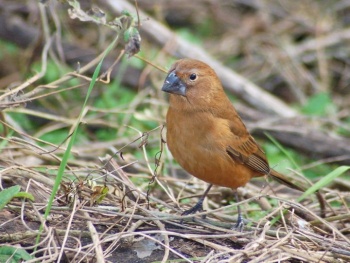(GSearches amended. Minor layout) |
m (Typos) |
||
| Line 12: | Line 12: | ||
==Taxonomy== | ==Taxonomy== | ||
[[Image:13220Cyanocompsabrissoni1.jpg|thumb|350px|right|Female<br />Photo by {{user|pablo|pablo}}<br />Buenos Aires, [[Argentina]] ]] | [[Image:13220Cyanocompsabrissoni1.jpg|thumb|350px|right|Female<br />Photo by {{user|pablo|pablo}}<br />Buenos Aires, [[Argentina]] ]] | ||
| − | ====Subspecies<sup>[[#References|[1]]]</sup> | + | ====Subspecies==== |
| − | + | There are 5 subspecies<sup>[[#References|[1]]]</sup>: | |
*''C. b. caucae'': | *''C. b. caucae'': | ||
:*Western [[Colombia]] (valleys of upper Río Patía, upper Cauca and Dagua) | :*Western [[Colombia]] (valleys of upper Río Patía, upper Cauca and Dagua) | ||
| Line 28: | Line 28: | ||
==Behaviour== | ==Behaviour== | ||
====Vocalisation==== | ====Vocalisation==== | ||
| − | '''Song''': recalls [[Blue-black Grosbeak]]'s but higher-pitched and faster; a flat warbled ''wee-se-weep wee-so-weeep wee see wee-so-weeep'' without latter's two slow introductory phrases. | + | '''Song''': recalls [[Blue-black Grosbeak]]'s but higher-pitched and faster; a flat warbled ''wee-se-weep wee-so-weeep wee see wee-so-weeep'' without latter's two slow introductory phrases.<br /> |
'''Call''': sharp, metallic ''pik'' call unlike that of Blue-black Grosbeak. | '''Call''': sharp, metallic ''pik'' call unlike that of Blue-black Grosbeak. | ||
==References== | ==References== | ||
| Line 43: | Line 43: | ||
==External Links== | ==External Links== | ||
{{GSearch|Grosbeak+brissonii Use "Grosbeak brissonii" to}} | {{GSearch|Grosbeak+brissonii Use "Grosbeak brissonii" to}} | ||
| − | {{GSearch|Cyanocompsa+cyanea Use | + | {{GSearch|Cyanocompsa+cyanea Use "Cyanocompsa cyanea''}} |
<!--EDITORS: There are a few scientific names, think these two searches find them all?--> | <!--EDITORS: There are a few scientific names, think these two searches find them all?--> | ||
[[Category:Birds]] [[Category:Cyanocompsa]] | [[Category:Birds]] [[Category:Cyanocompsa]] | ||
Revision as of 09:42, 27 July 2016
- Cyanocompsa brissonii
Cyanoloxia brissonii
Cyanocompsa cyanea
Identification
6" (15cm)
Very heavy black bill (slightly swollen)
Male: very similar to male Blue-black Grosbeak but slightly smaller, rump paler and brighter than back (not uniform with back), and bill somewhat curved and swollen.
Female: resembles female Blue-black Grosbeak but slightly smaller and pale sandy brown (not rich dark brown) with underparts obviously paler than upperparts.
Distribution
South America: In Colombia, pacific slope in drier parts of upper Dagua Valley (mostly above Cisneros), upper Patia Valley and mid Cauca Valley in Valle (Cali, Palmira, and Buga area). Spottily in north Venezuela, east Brazil, and Mato Grosso, Paraguay, Argentina, and east Bolivia.
Taxonomy
Subspecies
There are 5 subspecies[1]:
- C. b. caucae:
- Western Colombia (valleys of upper Río Patía, upper Cauca and Dagua)
- C. b. minor:
- Mountains of northern Venezuela (Falcón to Lara, Sucre and Monagas)
- C. b. brissonii:
- North-eastern Brazil (Piauí and Ceará to Bahia)
- C. b. sterea:
- C. b. argentina:
Habitat
Woodland and caatinga, thickets in semi-open areas. At heights around 300-1600m.
Behaviour
Vocalisation
Song: recalls Blue-black Grosbeak's but higher-pitched and faster; a flat warbled wee-se-weep wee-so-weeep wee see wee-so-weeep without latter's two slow introductory phrases.
Call: sharp, metallic pik call unlike that of Blue-black Grosbeak.
References
- Clements, JF. 2009. The Clements Checklist of Birds of the World. 6th ed., with updates to December 2009. Ithaca: Cornell Univ. Press. ISBN 978-0801445019.
Recommended Citation
- BirdForum Opus contributors. (2024) Ultramarine Grosbeak. In: BirdForum, the forum for wild birds and birding. Retrieved 18 April 2024 from https://www.birdforum.net/opus/Ultramarine_Grosbeak
Gallery
Click on images to see larger version






